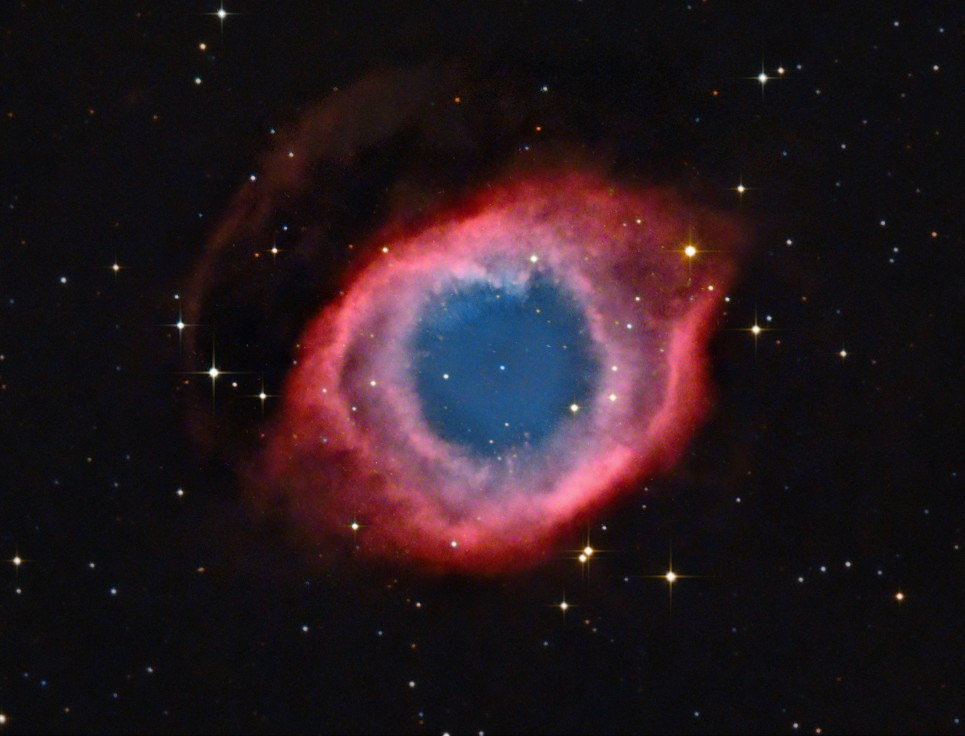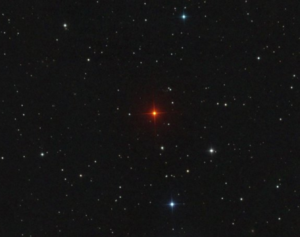
New and would-be amateur astronomers are often mystified and disappointed by the lack of color in things they see through their telescopes. And why shouldn’t they be? Popular astronomy shows, magazines, and web sites encourage people to believe that celestial objects are rich with blistering, saturated color, much like the image above. Why doesn’t that new $400 8-inch Dobsonian show bright pink nebulae, and galaxies of blue and gold?
The bland, nearly colorless truth is that few astronomical objects are deeply colored, or if they are, their light is too dim to activate the color-sensitive cone cells in the retinas of our eyes. Even the planets, bright as they are, show mostly muted colors. Many people have asked me why Saturn or Jupiter seen through my telescope are basically white. They aren’t always satisfied with my answer: these planets are, in fact, basically white, with only weak tints of brown, yellow, and whatever. Even Mars, the “Red Planet”, is more of a pale orangish-tan. As it turns out, the most colorful planet in the Solar System is probably the one we’re sitting on, and getting far enough away from it to take in its blue, green, and tan color is, at least at present, both expensive and uncomfortable.
The stars? They show weak tints ranging from pale orange to even more pale bluish-white. The only exceptions are the carbon stars and similar variables, which actually do exhibit fairly saturated shades of orange and red. But these stars are rare.

Yet not all is lost. There is one class of astronomical objects that can show serious color in a reasonably big amateur telescope—the planetary nebulae, those gently expanding puffs of gas given off by old stars in the process of giving up the ghost.
Like all emission nebulae, planetaries emit their light at a few discrete wavelengths. One of the strongest is that of triply ionized oxygen, or OIII (‘oh-three’), a blue-green wavelength that lies conveniently close to the maximum sensitivity of the human eye. This is a common emission wavelength of all luminous nebulae, but planetaries often have such a high surface brightness that their color is visible to our ordinary ‘Mark I Human Eyeballs’ when using a telescope.
Of course, the bigger the telescope, and the darker the sky, the more likely you are to have success with seeing color. A nice 20-inch reflector, for example, will do the job on many planetaries. But depending on their eyes and experience, many observers can see quite a bit of color with telescopes of half that aperture or less.
The brightest portions of planetary nebulae are dominated by that OIII wavelength, a rich turquoise color. The simpler planetaries, such as NGC 7662, the Blue Snowball Nebula in Andromeda, or NGC 6210 in Hercules, appear as mostly featureless aqua ellipses in such telescopes.

The situation is more complex with objects that display more internal structure, in particular the ring-shaped planetary nebulae. NGC 3242, the Ghost of Jupiter in Hydra, is a good example. I see its outer, brighter parts as strongly blue-green. The inner, darker region takes on a mysterious dark blue glow, sometimes with weird overtones of electric pink. The overall effect is that of an eerie cosmic swimming pool. The central star remnant takes on a strange aspect too, displaying an actinic purply-pink cast that befits its extremely high temperature of about 75,000K.
This description may seem fanciful to some observers. Color perception varies widely from person to person. To some, the Orion Nebula is just grey, no matter what telescope they use. To me, it has always looked emerald green in any telescope, though not so much now that I’m older. Still others see shades of pink and other colors, especially in larger scopes.
Even smaller telescopes can show some color. The famous Ring Nebula, M57, has a lower surface brightness than many other planetaries, but I can sometimes glimpse its colors in my 155mm refractor, though at other times it appears grey. Many smaller planetaries clearly show their turquoise tint through this small telescope, including the “Blinking Planetary” NGC 6826 in Cygnus, the Saturn Nebula NGC 7009 in Aquarius, and the Cat’s Eye Nebula 6543 in Draco. Because their surface brightness is so high, these objects can be examined at very high powers of 500x or more in optimal circumstances to see some of their internal structure.

Even the Dumbbell Nebula, M27 in Vulpecula, which has a fairly low surface brightness, sometimes shows a greenish cast in my 10” reflector.
The tiniest, most distant planetaries can often be distinguished from stars because of their color. In a crowded field of faint stars, you may still be able to pick out the planetary because it looks just a little bit out of place.
Unfortunately, the closest planetary nebula, the Helix (NGC 7293) in Aquarius, is an older, more dispersed object of low surface brightness. It’s too dim to show much color. But if it was as intense as the Blue Snowball, for example, it would be a spectacular naked-eye sight, a blue-green breath mint half the apparent size of the full Moon. Any planet lucky enough to be within a hundred light-years of such a gem would always have a glowing celestial eyeball to admire, or to fear.
Next time you’re out under the stars, dive into the tropical blue-green pools of planetary nebulae to add a splash of color to your observing routine.
Share This: